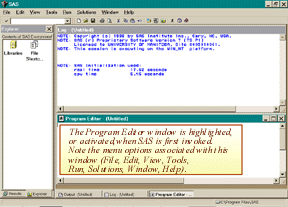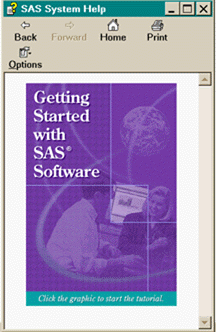|
This section provides a brief overview of the SAS windows environment, of how
to navigate within and among windows.
Navigation commands can be carried out in several ways:
- Command line - the command can be typed in the command box
at the upper left of the screen, or window-specific commands can be typed on
a command line (invoked using Tools/Options/Preferences/View in the SAS menu).
This method tends to be used less frequently because of the ease of use of the other,
newer, ways of navigating SAS windows.
- Pull-down menus - invoked by left-clicking on a menu heading.
Different menu options are available, depending on which window is activated.
- Pop-up menus - invoked by right-clicking on a window. Most
windows will have this option. They provide a useful way of accessing Help
menus.
- Keys window - assigns commands to keys/key combinations
(see description of Keys window below).
Right clicking on this window will display a pop-up menu which includes a
Help option; Help/Using This Window can be accessed to obtain a
list of examples of key commands.
- Toolbars - icons that provide shortcuts for a number of commands;
toolbars can be customized by going to the Tools/Customize menu.
The Programming Windows icon on the toolbar,
for example, can be used to restore the windows display to their default setting.
 |
When SAS is invoked five windows are automatically opened,
displaying labeled bars below each window. Left-clicking on
any of the five bars will activate the window. This is important
for carrying out any of the commands associated with a window.
|
The five windows are:
- Program editor - is used for creating and editing SAS programs
(and other kinds of ASCII files). Such tasks can also be accomplished with
the Notepad window (opened through the Explorer window
File/New/Source Program). SAS does not do anything with material
entered here until the program is submitted for processing (Submit/Run
on the Program Editor menu, or the runner on the toolbar).
- Log - displays information, once a SAS program is submitted for
processing, about how the program ran, or processed the information.
It is extremely important to examine the SAS log and to understand
its messages in order to ensure
that output has been generated as instructed; they facilitate
any debugging that may be required.
- Output - displays output, once a SAS program is submitted, such as tables
and graphs (if this is what has been specified in the program).
- Results - this window helps to manage SAS output.
- Explorer - this window is used to view and manage files/data
sets (similar to the Microsoft Windows version of Explorer). SAS
libraries, files, and shortcuts can be created within this window.
Another useful window is the Keys window, for creating shortcuts. This window is called up from
the Options menu, and shows how commands have been assigned to various keys and
combinations of keys. These can be changed and saved to suit your preference; some
useful key assignments are:
- next - to move through all the SAS windows that are open.
- recall - to bring back the most recently submitted set of
programming code back into the Program Editor window (this does not work in
any other window).
- clear - to clear everything within the activated window
(Program Editor, Log, or Output). This includes material not visible on the screen.
- undo - to undo the last keystroke (e.g., undo the clear
command if a window was inadvertently cleared).
| For additional information on how to navigate through the SAS windows environment,
new Windows users are referred to the tutorial
titled "Getting Started with SAS Software" under
the SAS Help menu, which is provided with the software. |
 |
 Home
Home |
NEXT
 General Guidelines: File management
General Guidelines: File management |
|




